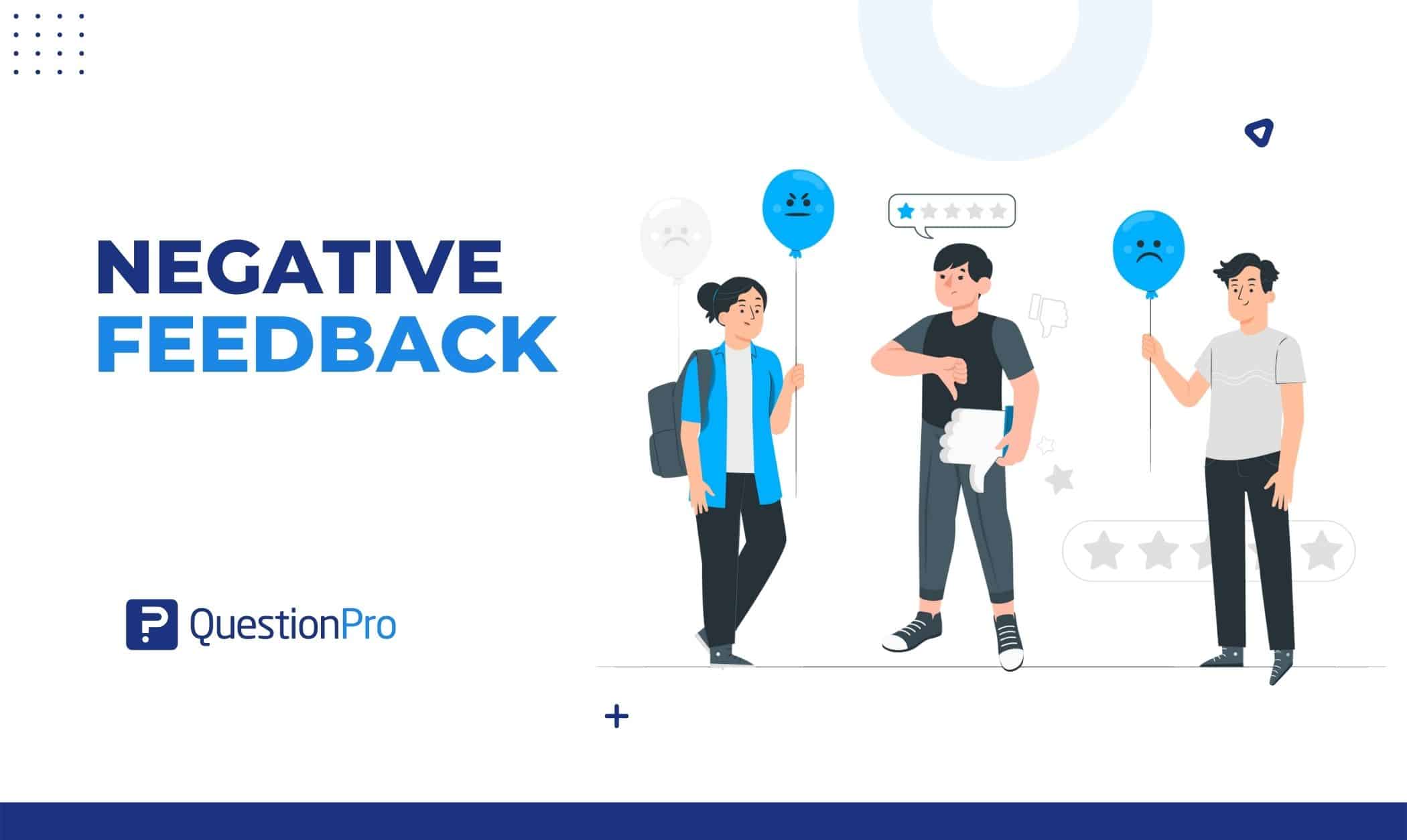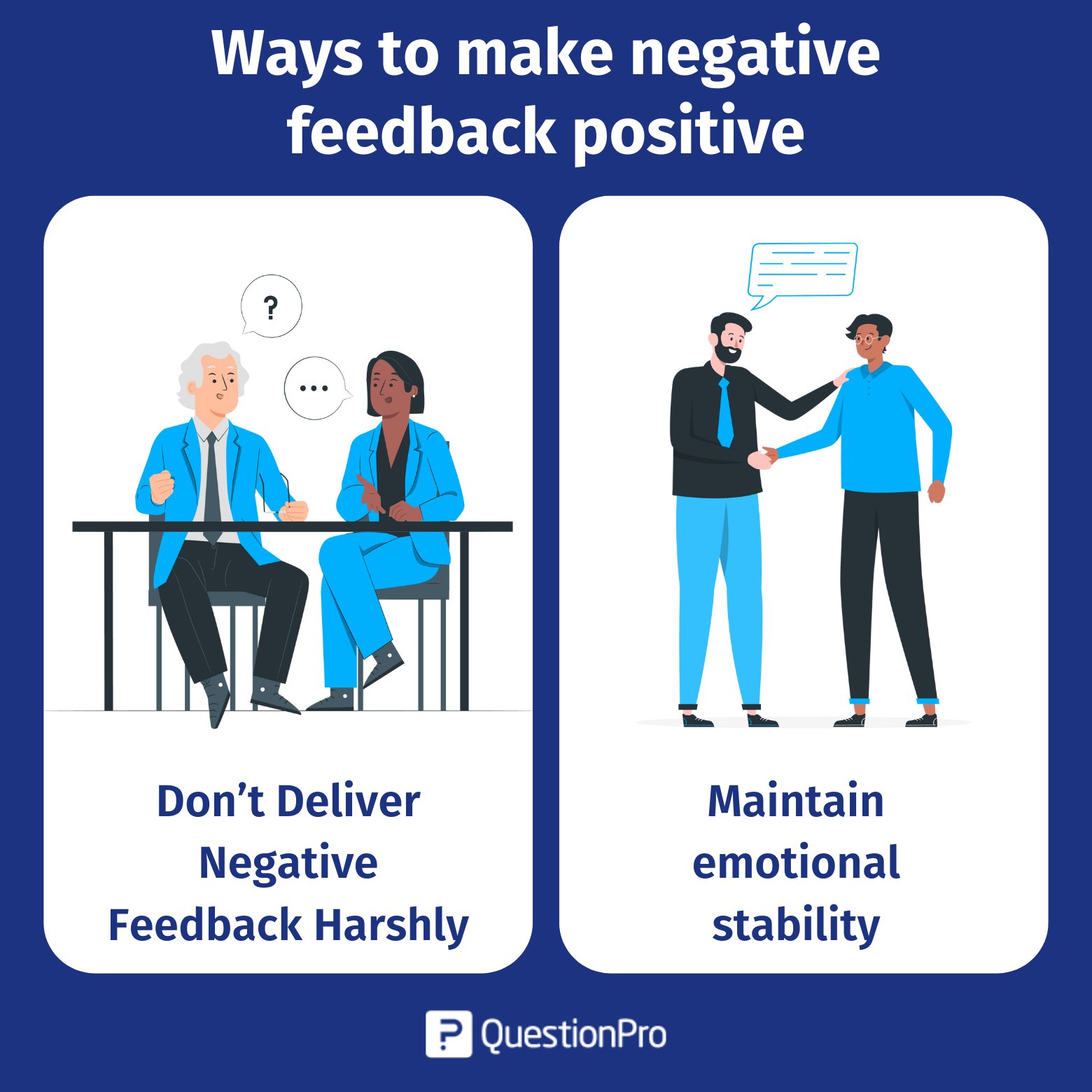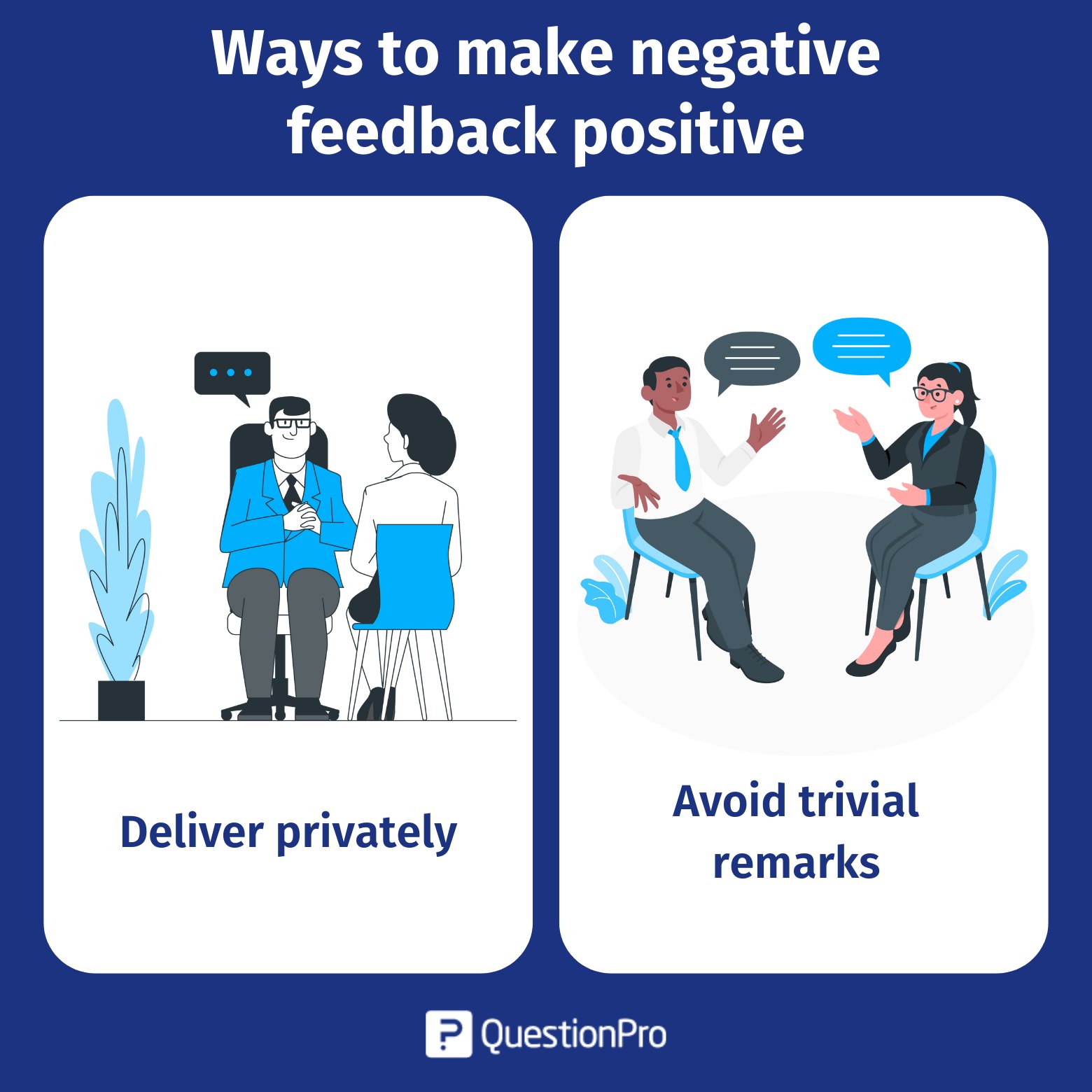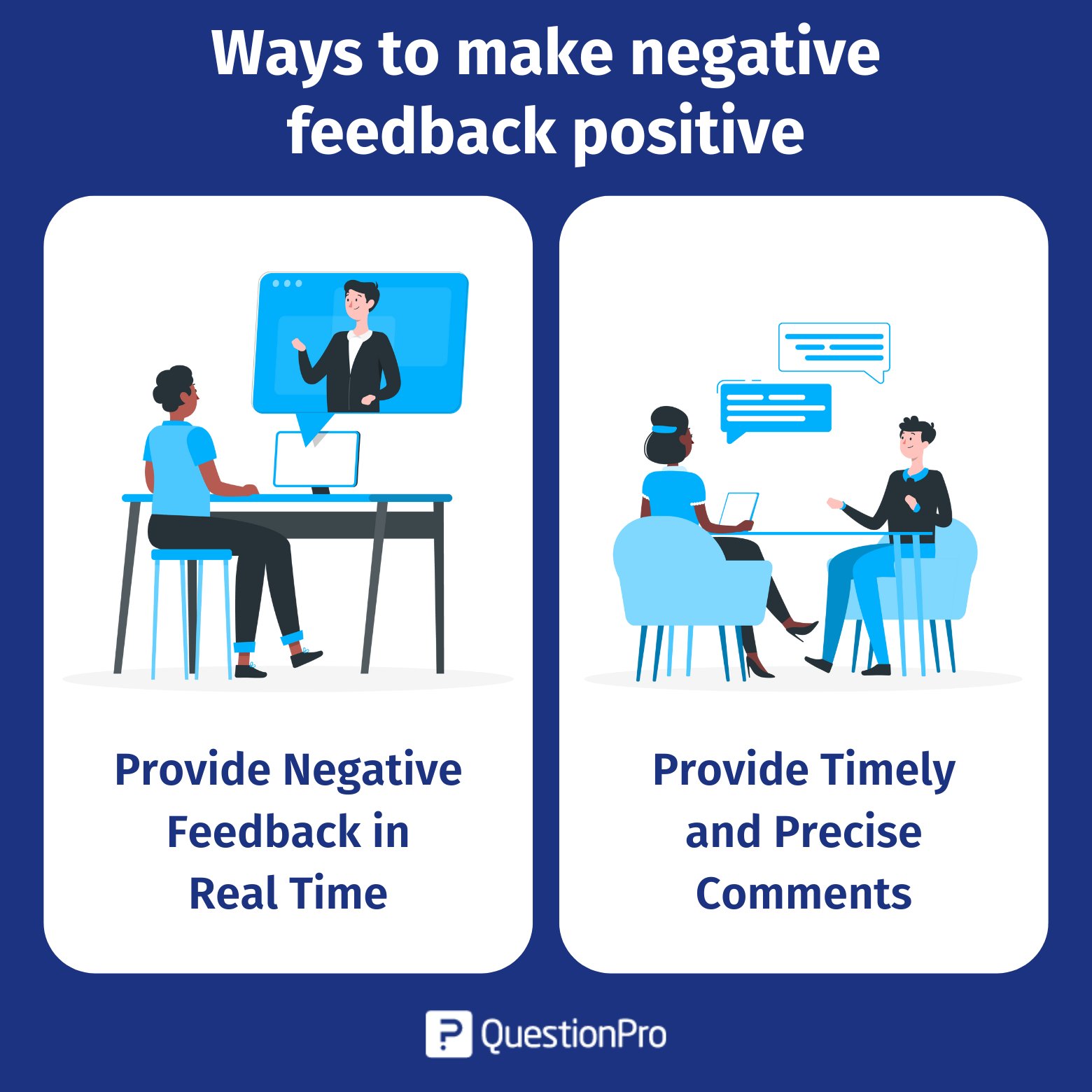
Giving feedback is frequently thought of as stressful, particularly if you have to provide negative feedback. The situation is made considerably worse when you know that an employee has a history of causing issues.
Employees’ productivity, enthusiasm, and faith in you are all influenced by how you deliver feedback. That’s why leaders must learn how to give constructive criticism.
Read on to learn how to develop your feedback abilities and turn constructive criticism into a win-win for everyone on your team.
What is negative feedback?
Negative feedback is information given to an employee to highlight actions that should be changed to avoid issues or poor performance. It aims to modify employee behavior to improve productivity and performance.
For example, If an employee files a contract wrong, the management should meet with them as soon as they receive it, not days or weeks later.
It is a valuable tool for boosting workplace efficiency. It can increase employee-manager connection and trust. Many employees appreciate and welcome constructive feedback from their managers, even if it makes them uncomfortable.
Learn more about what is Employee Trust and why it’s Important.
Importance of providing negative feedback
There are several reasons why it’s helpful to provide negative feedback. The following is a list of some of the primary reasons why this is the case:
- It leads to improved performance from employees.
- It facilitates growth in managerial leadership abilities.
- Ensures that employees are aware of their manager or the organization’s expectations of them.
- Assists workers in experiencing a sense of being supported and cared about while they are on the job.
- Employees are allowed to ask questions for clarification.
- Enhances the capacity of workers to carry out their work responsibilities.
Definition of positive feedback loop and negative feedback loop
Let’s explore the concepts of positive feedback loop and negative feedback loop, which are important to understanding how systems function and adapt. These mechanisms shed light on how processes either amplify or stabilize in response to change:
Positive feedback loop
A positive feedback loop refers to a self-amplifying process in a system where the effects of an initial change are enhanced over time, leading to exponential growth or reinforcement of the original change.
The output reinforces the input in this positive feedback mechanism, resulting in a continuous and escalating cycle. Positive feedback loops can drive systems towards extreme states or outcomes. They contrast with negative feedback loops, which act to stabilize or regulate a system.
Negative feedback loop
A negative feedback loop, also known as a negative feedback mechanism, is a regulatory process within a negative feedback system where the effects of an initial change are counteracted by subsequent changes, resulting in stabilization and equilibrium.
This type of feedback mechanism involves the system sensing a deviation from a set point and activating processes that reduce or reverse that deviation. Negative feedback loops are fundamental for maintaining homeostasis and stability in various natural and artificial systems.
They serve as a negative feedback control mechanism, minimizing deviations from desired states.
A positive feedback loop reinforces change and can lead to amplified effects, while a negative feedback loop counteracts change and promotes stability through self-regulation. Understanding both positive and negative feedback mechanisms is crucial for comprehending the behavior and dynamics of complex systems across various domains.
Learn about Feedback Loop and how it functions within organizations!
Ways to make negative feedback positive
Giving positive feedback is easy, but giving negative feedback is harder. Employees aren’t receptive to it if it is not done properly. Here are ways to give negative feedback to employees:
Don’t Deliver Negative Feedback Harshly
Give feedback with care and respect. If given too frequently and without feeling, the recipient will go into defensive mode and may lose trust, confidence, and enthusiasm.
To avoid harsh delivery:
- Use calm language.
- Focus on observations, not judgments.
- Look for ways to solve issues together, not just point out mistakes.
- Replace “always” or “never” with more neutral language like “sometimes” or “recently”.
For example, instead of saying, “Your work is always late and never accurate”, say: “I’ve noticed some delays and inaccuracies lately; let’s look at how we can fix these”.

Maintain Emotional Stability
Before giving negative feedback, calm down. When angry, furious, or negative, it’s hard to give useful feedback.
To stay calm when giving feedback:
- Take a moment to assess your feelings and approach calmly.
- Schedule feedback sessions after breaks or at quiet times of the day.
- Take a few deep breaths before the conversation to keep your emotions in check.
- Focus on the goal and imagine how you’d feel in their shoes to add a layer of empathy.
Give Behavior-based, Not Person-based Feedback
It’s better to focus on the desired change in behavior, not the person. Here are ways to focus on behaviors, not personal attributes, when giving feedback:
- Describe the Action, Not the Person: Instead of saying, “You’re always late”, say, “I’ve noticed delays in recent project submissions”.
- Use Objective Language: Keep language neutral and fact-based, such as “The report was missing some sections” instead of “You didn’t complete the report”.
- Highlight the Impact: Explain the impact of the behavior on the team or project, such as “When reports are late, it affects the team’s planning”.
- Suggest Solutions Together: Invite collaboration by saying, “Let’s brainstorm ways to improve time management” instead of assuming the employee knows what to do next.
- Separate Behavior from Identity: Use language like “This specific task could use more attention to detail” instead of generalizing with “You’re not detail-oriented”.
- Acknowledge Positive Behaviors: Balance the feedback by mentioning where they excel, e.g., “Your client follow-up is great; let’s get that level of consistency in documentation”.
Deliver Privately
Never give negative feedback in front of colleagues. The employee will feel embarrassed and restricted by the feedback. Meet the person in your office or a meeting room. Doing so will show the employee respect and get them to be more open to your feedback.
To deliver feedback privately, you can:
- Schedule the feedback in a closed office or meeting room.
- Set a specific time rather than surprising the employee so they can prepare mentally.
- Be confidential.
- Start with an invitation for the employee to share their perspective first.

Avoid Trivial Remarks
Sometimes, leaders or managers start the conversation with negative feedback, trivial comments, or unjustified praise.
When giving constructive feedback, keep your focus on the facts and try to be as honest, practical, and open as possible. The employee will respond in kind. You can:
- Skip unnecessary praise before critical feedback; it feels forced.
- Get to the point without small talk.
- Be direct with feedback and respectful.
- Avoid vague language; say exactly what needs to change.
- Skip the “sandwich” approach; rather than softening the message, ensure clear and actionable feedback.
Don’t Freak Out
Giving negative feedback can be hard if the issue is big or the employee is defensive.
Here are some tips to stay calm when giving feedback:
- Keep your voice calm even if they get defensive.
- Manage your body language, no crossed arms, no pointing, and make eye contact to show respect.
- Outline the key points beforehand so you don’t get sidetracked by emotions.
- Let them talk and respond thoughtfully, which can help diffuse the tension.
Let Employee Respond
Give feedback in a conversation. Once you’ve covered the behavior and what needs to change, let the employee respond and ask questions. This shows you value their time and opinion.
Here’s how to get the employee to talk during a feedback conversation:
- Pause and Prompt: After you’ve given your feedback, pause and say, “What are your thoughts on this?”
- Ask Open-Ended Questions: Use questions like “How do you feel about that?” or “Do you see any issues with those suggestions?”
- Encourage Reflection: Say, “Take a moment and think about it, and let’s talk about any insights or concerns you have”.
- Invite Suggestions: Prompt with “What do you think would help with this?”
- Acknowledge Concerns: If they bring up concerns, say “I appreciate you bringing that up; let’s figure out how we can work around that”.
- Be Receptive: Say, “I’m here to help, so let me know how I can help with this”.
Provide Negative Feedback in Real Time
The timing of negative feedback is critical. Give feedback as soon as the desired behavior happens so the employee can act quickly.
You can:
- Have a weekly or bi-weekly feedback schedule to address small issues as they come up.
- Address specific actions or outcomes from recent work.
- Give feedback asap.
- If you can’t meet in person, immediately send a quick note or schedule a virtual meeting to address the issue directly.

Be Specific
You should provide timely and precise comments. Instead of saying, “You did the form wrong,” explain what they did wrong and how to fix it.
To be clear and specific, you can:
- Specify what needs to change.
- Explain how it ties to team or company goals.
- Use examples if they help clarify expectations.
- Give action steps like reviewing last quarter’s data and updating accordingly.
- Explain how addressing the feedback will contribute to overall success.
Make An Action Plan
Create a note or action plan after you’ve explained the issue. Set employee performance targets and deadlines. You can check in weekly or monthly.
Here’s what to do after you’ve discussed an issue:
- Work with the employee to outline the plan.
- Define clear and achievable objectives.
- Set realistic deadlines for each goal to create a sense of urgency.
- Schedule regular check-ins to review progress.
- Discuss any additional resources, training, or support the employee may need.
- Write down the action plan and share it with the employee for clarity and accountability.
- Let the employee input into the plan to get them to own and commit.
Plan When to Follow Up
Schedule a date and time to follow up with the employee and review the note or action plan. It is key to regularly check in and give positive feedback on progress.
Here’s how to follow up after feedback:
- Set up specific dates for follow-up meetings in advance to hold accountability.
- Use these meetings to review the employee’s progress on the action plan and any issues they face.
- Recognize and praise any positive changes or successes to motivate the employee.
- Offer support and resources if the employee is struggling or needs help.
- Create space for the employee to ask questions or share concerns about their progress.
- Be flexible and willing to adjust goals or approaches based on the employee’s feedback and progress.
- Keep notes on each check-in to track improvements and areas needing further attention.
Learn about Feedback Management Software. Build and deploy smart surveys and collect feedback to drive performance.
Examples to Provide Negative Feedback Positively
Practice, experience, and observation are crucial for doing anything well. It can be challenging to provide feedback in a suitable and sophisticated manner. The examples below could serve as a place to start:
- Remarks: You keep missing deadlines, which is affecting the project and the rest of the team.
Positive alternatives: I’ve seen that you struggle with time management. Is there anything you need from me to help?
- Remarks: Your goal wasn’t fulfilled. It concerns me that it will affect the team’s performance.
Positive alternatives: I know how hard you have worked even though you haven’t reached your goals. Do you have any roadblocks that I can help you with?
- Remarks: Your late-night emails to the team have troubled me because you don’t seem to be in charge of your work.
Positive alternatives: I’m concerned about your work-life balance because I’ve seen your late-night emails to the staff. Can you go into more detail so we can better understand your workload?
- Remarks: You’ve taken on the new responsibilities but don’t appear to be managing them well.
Positive alternatives: Congrats on your new position. There must be difficulties. Can we talk about any possible training and support?
- Remarks: In the meeting yesterday, you were irritated, which made making a decision quite difficult.
Positive alternatives: In yesterday’s meeting, I observed that you seemed upset. Could you please let me know how things are going?
Conclusion
Giving feedback is a necessary part of people management. However, it can be challenging. The person you are giving feedback to will recognize your sincerity when you are committed to employee development. Use the ways outlined in this blog to provide negative feedback positively.
Carefully handle negative reviews. Explore ways, learn from examples, and give feedback for progress. The provider should realize the activity’s objective and motivation. They must also evaluate personal and contextual situations and know what information they lack.
Discover how to improve your company by regularly collecting feedback from your workforce with the help of QuestionPro. The QuestionPro Workforce will assist you in determining your capacity to offer negative feedback. You can survey your employees to learn what they think about this.
Frequently Asked Questions (FAQ)
Negative feedback is constructive criticism or evaluative input provided to help improve performance or outcomes.
Negative feedback highlights weaknesses and allows individuals to work on enhancing their skills.
Approach negative feedback with an open mind, view it as an opportunity to learn and avoid becoming defensive.







